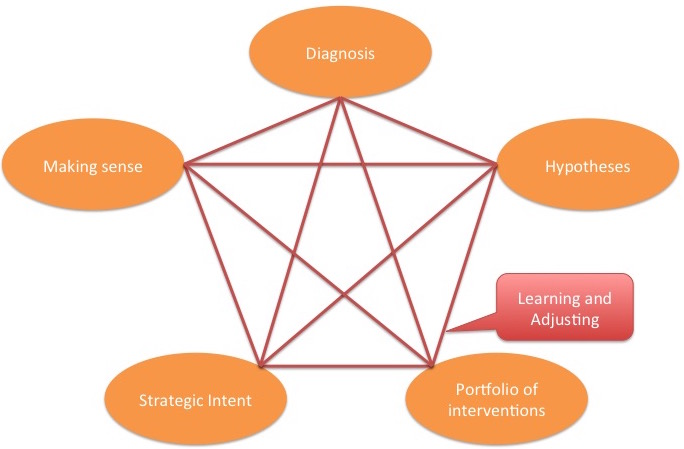I have been blogging quite extensively about the Theory of Change (ToC) approach in recent months. My blog posts reflect a process that I have been going through as part of my different work engagements: adapt ToC approaches to be more sensitive to the complexities development programmes face in their day-to-day work.

Different phases of Systemic Insight
In parallel, with my colleagues at Mesopartner we keep doing research on understanding complex realities and our human reaction to them based on cognitive science, understanding the process of economic change, making decisions under conditions of uncertainty, and managing highly resilient organisations. In these contexts, ToC has limited applicability and a number of drawbacks. Therefore, we have been working on an alternative approach to the ToC approach which we built from the ground up based on our growing understanding of how complex systems work and how involved actors can lead a process of exploration and change. The approach is called Systemic Insight.
My journey to adapt ToC approaches started off here with introducing an element of situational awareness in the process, where the stakeholders involved in designing the ToC ask themselves which of the pathways of change they think are necessary are going to be linear and predictable or complex and emergent. This allows the project management to decide what can be managed traditionally ‘log-frame style’ and what needs to be approached in a more explorative, complexity sensitive way. In follow up posts (here, here and here) I discussed how existing ToCs can be adapted, how diversity and dissent are an asset when working in complex contexts and that ToCs should not be over-designed as the more detailed they are the more they constrain options for the teams to experiment and explore.
My last two posts (here and here) discussed possible new structures for ToC representations that take into account the thinking of the first few posts. Particularly, they encourage the teams to first develop a conceptual understanding of how change happens in a given context by diving into current scientific understanding and knowledge. This conceptual understanding then gives the frame for the system-level transformations the projects target. No direct causal pathways are designed. Iteratively planned interventions are intended to trigger system-level change and causal pathways and attribution is only revealed ex-post.
This has been a really interesting and rich journey and I intent to continue with it. I believe that this way of using a ToC approach can be highly beneficial for programmes operating in complex contexts. Particularly for teams who are used to this way of planning, implementing and managing projects using a complexity aware ToC approach takes them a step towards better adapt their interventions and logic to how complex systems change.
I received a couple of really good and challenging comments to my last blog post from Michaela and bhavfish that resonated with the fundamental unease that I’m still having with ToCs in complex contexts. Also, I stumbled over this blog post from Geoff Mulgan over at Nesta, that points out a few things that are ‘wrong’ with ToC. Thinking about these and the consequences for ToC made me realise that we need to rebuild an approach from the ground up to respond to these issues.
It is a bit like with electric cars. Many manufacturer retrofit some of their existing models with batteries and electric engines. But there will allows be some fundamental flaws in the design of these electric cars as they were originally built for combustion engines – for example their weight and the location of the battery. There is a clear path dependency in these companies that limits their options. Tesla in contrast has redesigned their electric car from the ground up without the ‘ballast’ of existing car designs. It is genuinely adapted to being driven by a different type of engine and the requirement to carry heavy batteries.
At Mesopartner, we haven been doing exactly this over the last couple of years. We just haven’t explicitly seen our Systemic Insight approach as an alternative to ToC. But when I think about it, that is exactly what it is. It helps groups of people who want to engage in a change process to design and manage such a process of exploration and learning.
Now, I still think that for many teams the ToC approach with the suggested adaptations works really well and can continue to work. Especially those teams who feel the same path dependence and might be unable to adopt a completely new approach – and I will continue to work with ToC and support teams on using them. It’s a good compromise – being Swiss I know the value of good compromises. But the teams that have the freedom to work without a ‘logic model’ that requires us to define some sort of causal pathway towards an idealistic target, the teams that are free to genuinely explore and experiment, those teams should give Systemic Insight a try as an alternative. It is an approach that is built on joint sensemaking, decentralised decision making and flexible resource allocation, enabling us to explore options and nudge systems into the adjacent possible.
If you want to know more about Systemic Insight, we are curating a website where we document the approach and the journey to get to the approach. It also hosts a couple of podcasts with discussions on complexity and development, among others with Dave Snowden. Here is a
PDF that describes the approach in seven pages. Shortest we could do …
